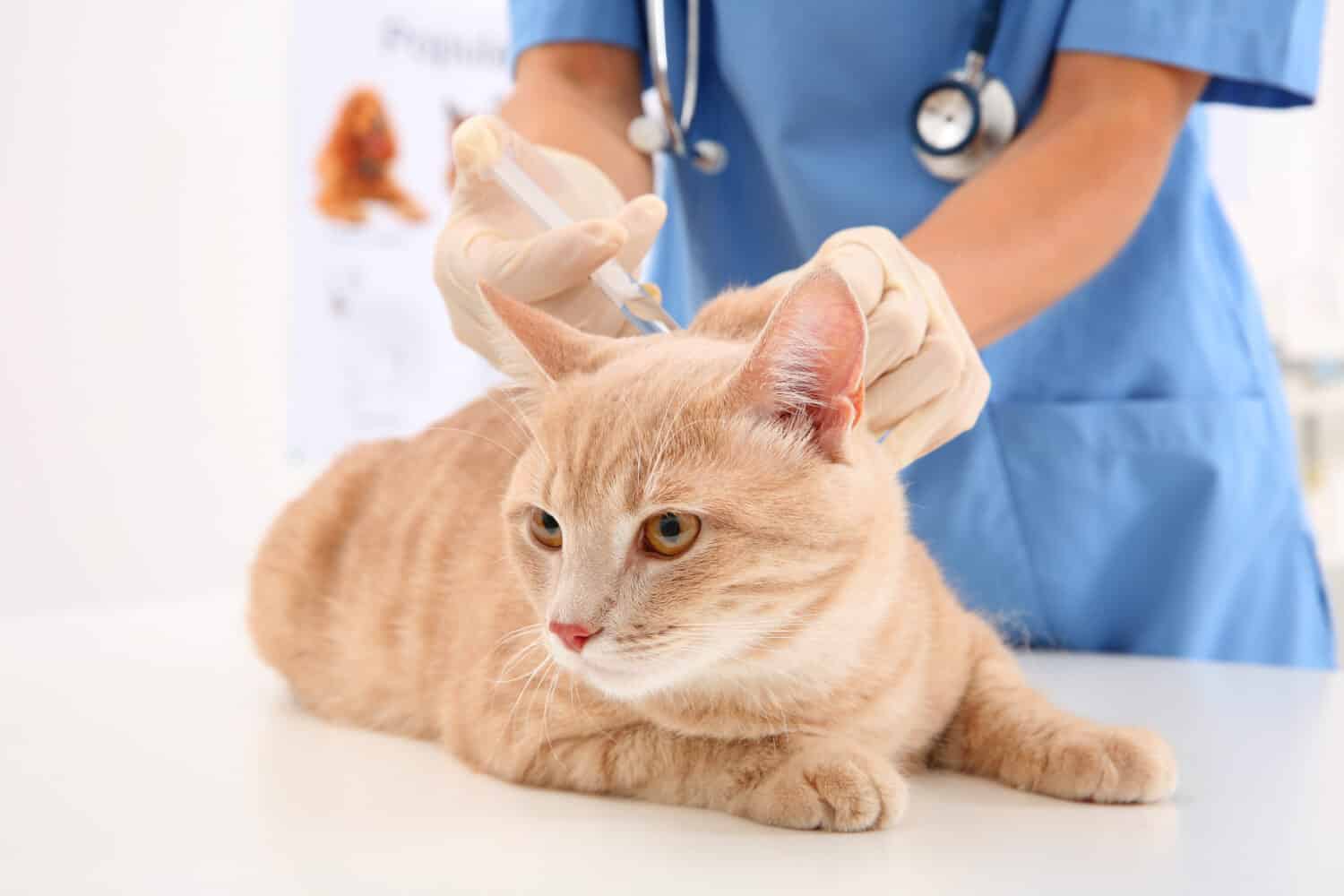What are the signs of rabies in cats? According to the Centers for Disease Control and Prevention, approximately 250 cats test positive for rabies each year in the United States. Hollywood has made multiple major motion pictures featuring rabid dogs, including the 1957 Disney film Old Yeller, the 1962 classic To Kill a Mockingbird, and the 1983 Stephen King film Cujo. But rabid cats rarely make the big screen, and the signs of the virus in cats can vary significantly from the signs of rabies in dogs.
Many early signs of rabies could also indicate other common illnesses. Therefore, owners can have a difficult time telling if their cat is just under the weather or possibly in the early stages of a horrible death. Thankfully, rabies in cats is rare, but it is still important to know what signs to look for because the virus can potentially kill anyone who is exposed to the saliva of an infected cat.
Clinical Signs of Rabies in Cats
The clinical signs of rabies in cats do not appear until after the incubation period of the virus, which can last from just a few days to more than a year. Signs of rabies typically appear sooner in cats than in dogs, within about 3 to 8 weeks. Rabies causes inflammation of the brain, known as acute encephalitis. This inflammation causes cats to display a variety of abnormal behaviors and other signs.
Rabies in cats usually occurs in three stages: the prodromal stage, the furious stage, and the paralytic stage. The prodromal stage lasts about 2 to 4 days, followed by the furious stage and the paralytic stage, which usually occurs after about 7 days. Cats typically die within about 10 to 14 days after signs appear. A cat infected with rabies may show any combination of the following signs. Please note that once signs appear, the cat is already infectious, so take extreme caution when handling the animal. Doctors can provide no treatment or cure for rabies once signs of the disease present themselves.
The Prodromal Stage

The early stage of rabies, when signs of the disease first appear, may mimic many other illnesses.
©Oporty786/Shutterstock.com
Fever
One of the earliest signs of rabies in cats is fever. Of course, fever could indicate any number of different ailments. Cats with rabies may have a low fever or a high fever. They may not have a discernable change in temperature at all. Look for fever along with other signs of infection, especially if you believe that your cat was bitten or otherwise exposed to the virus.
Fatigue
In the early stages of the disease, cats with rabies will most likely appear fatigued. They may seem listless, with much less energy than usual. This sign usually occurs alongside fever during the first two to four days following the incubation period.
Altered Vocalization
If you own a cat, you likely know its many various vocalizations. You know how it meows when it wants to be fed, as opposed to how it cries when it has something to protest. One of the early signs of rabies in cats may include changes in how they vocalize due to spasms in their larynx.
Decreased Appetite
As the virus affects the larynx, cats normally experience decreased appetite and a reluctance to eat or drink. This happens because the cat finds it more and more difficult to swallow.
Abnormal Behavior
Rabies may cause a cat to exhibit unusual behavior. Normally friendly and outgoing cats may suddenly act withdrawn, shy, or scared. Quiet and docile cats may become aggressive and irritable. Cats that normally avoid cuddles can turn clingy. Owners should take seriously any sudden, abnormal behavior coupled with fever or lethargy following potential exposure to rabies.
The Furious Stage

Cats in the furious stage of rabies infection may attack without warning, posing great danger to humans.
©SerPhoto/Shutterstock.com
Aggression
After the first 2 to 4 days of visible signs of the disease, a cat with rabies will transition to the furious stage of the disease. This phase often features moderate to severe aggression toward other animals or humans. Cats may seem to hallucinate and react to things that do not exist. Behaviors may include unprovoked attacks, biting and scratching at inanimate objects or even the air, and other agitated behaviors. Confined cats may attack the bars of their crate or even bite and mutilate their own body.
The Paralytic Stage

The final stage of rabies in cats is the paralytic stage, which ultimately ends in death.
©Kitirinya/Shutterstock.com
Weakness or Paralysis
By about 7 days after signs of rabies first appear, cats will enter the paralytic stage of the disease. As they reach this stage, they may become very lethargic. They will have increased difficulty moving and may show signs of paralysis.
Excessive Drooling
The familiar “foaming of the mouth” associated with rabies does not typically occur until this stage, as the cat’s inability to swallow properly causes them to have excessive amounts of drool.
Seizures
Cats in the late stages of rabies may suffer from seizures. These seizures can include twitches and convulsions, but they can also present as temporary paralysis. Cats at this stage of the disease may slip into a coma before they ultimately die.
Timeline of Rabies Infection in Cats
Rabies infection usually begins with a bite or scratch from an infected animal. The virus that causes rabies is passed through the saliva. Cats may also become infected if a rabid animal’s saliva contacts an existing wound or a mucus membrane, such as the eyes.
Cat owners should be aware that the incubation period for rabies, meaning the time between exposure to the virus to the time when signs or symptoms appear, can last a very long time. Although signs of the disease typically show up within about 8 weeks of exposure, it can take a year or more for the disease to become evident. The virus must travel from the site of exposure to the brain and multiply there before the cat becomes infectious. Once the virus reaches the salivary glands, the cat becomes infectious and will soon begin to show signs of the disease.
Rabies can be prevented in cats if they are treated quickly after exposure but before they become infectious. Sadly, no treatment or cure exists for cats once signs of rabies infection appear. Once clinical signs of rabies appear in a cat, death will occur within about 10 days.
What to Do if You Suspect Rabies
It can be heartbreaking to reach out for help if your cat is showing signs of rabies. Knowing that your cat will soon die, and must be euthanized if rabies is confirmed, can be enough to make anyone a little hesitant to make that call. But continuing to care for a rabid cat at home can be extremely dangerous, and potentially deadly for you and your family.
If you suspect that your cat has rabies, confine it in a crate or other secure location and avoid any physical contact. Call your veterinarian or animal control immediately. Do not transport your potentially rabid cat to a veterinary office or hospital without being instructed to do so. Your veterinarian will probably want to examine your cat outside of office hours to minimize the risk of spreading rabies to other animals or humans.
What to Do in Case of Possible Rabies Exposure

Cats that have been vaccinated for rabies at least once have a greater chance of survival if exposed.
©Africa Studio/Shutterstock.com
You must act as quickly as you can to increase your cat’s chances of survival if they may have been exposed to rabies. Be honest about your cat’s vaccination status and provide records if at all possible. According to the Centers for Disease Control and Prevention, the protocol for dealing with rabies exposure in cats depends on whether the cat has been vaccinated, and how recently their last vaccine was administered. Accurate testing for rabies in cats can only be done after the animal is euthanized, by examining its brain. But euthanasia may not be necessary, depending on the cat’s vaccination status.
Cats That Have Current Vaccinations
If your cat is up to date on its rabies vaccine at the time of a possible rabies exposure, it will have the best chance of survival. The CDC recommends that exposed cats receive a rabies booster vaccine and quarantine at home for 45 days. If they show signs of rabies during the quarantine period, they must be euthanized. If they remain healthy throughout the 45 days, owners may presume they are free of the disease.
Cats Overdue for Vaccinations
Cats that have had at least one rabies vaccination, but are overdue for their most recent booster, may also avoid euthanasia. They should receive an immediate booster vaccine after possible rabies exposure, then quarantine at home for 45 days. If they show signs of rabies during the quarantine period, they must be euthanized.
Cats Without Vaccinations
Cats that have never received a rabies vaccination are most at risk of catching the disease. If exposed to rabies, the CDC recommends that an unvaccinated cat should be euthanized immediately. If the owners refuse, they must quarantine the cat for at least four months. During the four-month quarantine period, if the cat shows signs of rabies it must be euthanized.
Preventing Rabies in Cats
Cat owners can easily prevent rabies infections in their pets. Vaccinations are relatively inexpensive, and community clinics sometimes offer them for free. This horrible virus kills animals in a painful, torturous way, but prevention is as simple as getting your cat a shot every one to three years. Of course, spaying and neutering cats also helps to prevent the number of strays in a community, thus reducing the risk of the spread of rabies and other diseases.
The photo featured at the top of this post is © SerPhoto/Shutterstock.com
Thank you for reading! Have some feedback for us? Contact the AZ Animals editorial team.







